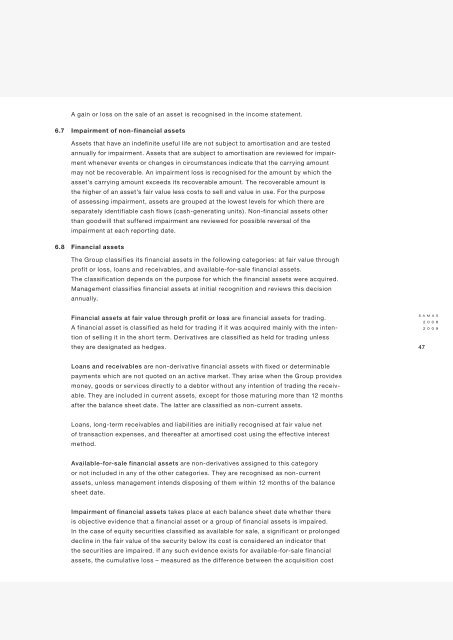Annual Report Samas NV 2008 2009 Annual ... - Alle jaarverslagen
Annual Report Samas NV 2008 2009 Annual ... - Alle jaarverslagen
Annual Report Samas NV 2008 2009 Annual ... - Alle jaarverslagen
- No tags were found...
Create successful ePaper yourself
Turn your PDF publications into a flip-book with our unique Google optimized e-Paper software.
A gain or loss on the sale of an asset is recognised in the income statement.6.7 Impairment of non-financial assetsAssets that have an indefinite useful life are not subject to amortisation and are testedannually for impairment. Assets that are subject to amortisation are reviewed for impairmentwhenever events or changes in circumstances indicate that the carrying amountmay not be recoverable. An impairment loss is recognised for the amount by which theasset’s carrying amount exceeds its recoverable amount. The recoverable amount isthe higher of an asset’s fair value less costs to sell and value in use. For the purposeof assessing impairment, assets are grouped at the lowest levels for which there areseparately identifiable cash flows (cash-generating units). Non-financial assets otherthan goodwill that suffered impairment are reviewed for possible reversal of theimpairment at each reporting date.6.8 Financial assetsThe Group classifies its financial assets in the following categories: at fair value throughprofit or loss, loans and receivables, and available-for-sale financial assets.The classification depends on the purpose for which the financial assets were acquired.Management classifies financial assets at initial recognition and reviews this decisionannually.Financial assets at fair value through profit or loss are financial assets for trading.A financial asset is classified as held for trading if it was acquired mainly with the intentionof selling it in the short term. Derivatives are classified as held for trading unlessthey are designated as hedges.S a m a s2 0 0 82 0 0 947Loans and receivables are non-derivative financial assets with fixed or determinablepayments which are not quoted on an active market. They arise when the Group providesmoney, goods or services directly to a debtor without any intention of trading the receivable.They are included in current assets, except for those maturing more than 12 monthsafter the balance sheet date. The latter are classified as non-current assets.Loans, long-term receivables and liabilities are initially recognised at fair value netof transaction expenses, and thereafter at amortised cost using the effective interestmethod.Available-for-sale financial assets are non-derivatives assigned to this categoryor not included in any of the other categories. They are recognised as non-currentassets, unless management intends disposing of them within 12 months of the balancesheet date.Impairment of financial assets takes place at each balance sheet date whether thereis objective evidence that a financial asset or a group of financial assets is impaired.In the case of equity securities classified as available for sale, a significant or prolongeddecline in the fair value of the security below its cost is considered an indicator thatthe securities are impaired. If any such evidence exists for available-for-sale financialassets, the cumulative loss – measured as the difference between the acquisition cost

















